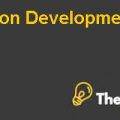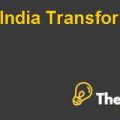
Statement of Problem
The unforeseen challenges that came along with the acquisition REPOWER are among the toughest that Tulsi Tanti has ever faced. Suzlonhas entered the market with the big fishes in the field of wind turbine solutions and the competitors are all set to give a fierce competition and Suzlon findsit hard to match up to their (global competitors) standards because Suzlon being an Indian based company, does not know for manufacturing hardware. Apart from this, they have never really focused on the R&D department; inflow of debt hasbecome insufficient and very expensive after the collapse of Lehman brothers.Tanti had paid more than needed to acquire REPOWER and now most of the debt is largely coming from REPOWER.
Analysis of Issues:
Tanti operated his company well how ever, he is currently facing growth and performance crisis after the possession of repower as he is finding it hard to maintain 50% annual growth target.
SWOT Analysis
Strengths:
Suzlon has grown a lot since 1995, and has been rapidly increasing its share in the global market since then. The main reasons behind its rapid growth are the acquisitions of the manufacturing companies and the skilled force behind it. He not only seeks to possess a manufacturing plant but capable employees as well.He has a mixture of the workforce, which consists of Germans and Dutch, and they are the leaders in the turbine industry.He knows that it would be foolish to let go of the skilled workers and personnel who are already working for turbine companies and with every acquisition Suzlon’s portfolio would improve. The vision of having a diversified team and being able to manufacture every part of the turbine themselves rather than outsourcing could be very cost effective and in the long run, this could turn out to be a game changing step. Suzlon's low manufacturing cost and operational efficiency to gain competitive advantage over rivals and could act as a strength.
Weaknesses:
The main draw back of Suzlon is that is is investing almost nothing into research, for example, Vestas invested approximately US$318 million in R&D in 2008, which is about 3.8% of its revenueas compared to this, Suzlon was nowhere in the R&D department as ithad spent and amount almost to nothing on research. In the same year, Suzlon invested US$10 million dollars in R&D, which is 0.69% of its revenues. It is a company supported by a good R&D department which has a strong portfolio with many other patents under its belts.In this era, things become obsolete even before they are launched and Tanti can not expect himself to survive if he is not willing to cope up.
In the beginning, when Suzlon started acquiring different companies, it turned out to be beneficial for him however,now as he has a better portfolio, he should choose his next acquisitions wisely because most of the debts he has on him right now are from re power.
Opportunities:
The scopeto gathera chunk of the global market is huge for Suzlon, byhaving a diversified workforce Tantican claim to have the most expertise in the turbine industry while having deep pockets. The workforce consists of Germans, Dutch and Austrians working for him as well, which could lead to different input into on the research platform if utilized efficiently and funded well.
Suzlon should not let go of the Indian market, though he is already a market leader however,he should sustain the India market as an opportunity because he does not want to lose the market share in India to any other company.
Threats:
The main threat to Suzlon is the non-availability of debts due to the collapse of Lehman brothers, they were the highest investors in the turbine services and manufacturing, and a lot of debt is directed towards Suzlon by repower and it is posing a threat to the existence of the company.
Apart from European and American competitors, Suzlon is facing a new threat, the Chinese manufacturer, namely Sin novel and Gold wind. The rapidly growing Chinese market was being catered by them. Due to the new energy laws being implemented in China, China has accounted for nearly one-third of the global increase in the wind power capacity. The Chinese government enforced a 70% local content rule to reduce imports. As a result, the country had about 80 wind turbine manufacturers, Sin novel and Gold wind being the largest of them.
Porter’s Five Forces Analysis
Buyer Power (Moderate):There are very few potential buyers, they are sensitive to pricing and power purchase structure.
Threat of Substitutes (Moderate to High): Other renewable energies, Price substitution from conventional sources, falling oil and gas prices.
Supplier Power (Moderate): High demand for composites and backward integration by key players.
Entry Barriers (High): Investment costs in technology, Quality control standards and Lack of experience.
Industry Rivalry (Moderate to High):There are high costs, competitive pricing and large or global players.................
This is just a sample partial case solution. Please place the order on the website to order your own originally done case solution.













